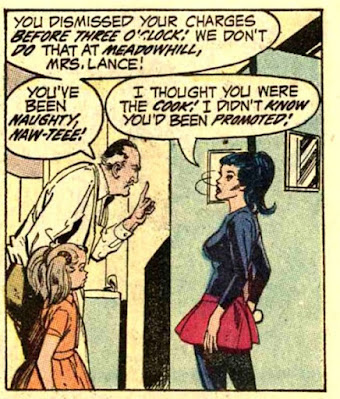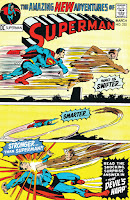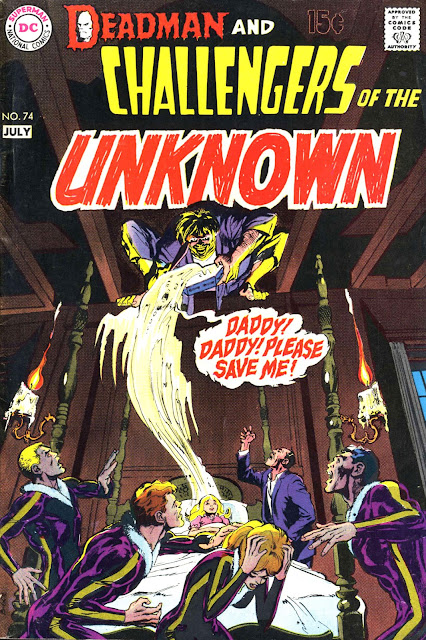GREEN LANTERN #83 May 1971
"Never again will super-heroes interfere with our orderly world!" bellows the fist-clenching, narrow-eyed figure on the cover of GREEN LANTERN #83, "DESTROY THEM!" Our heroes recoil in horror at whatever it is that is casting a huge shadow over them-- "We can't fight that!" wails Green Lantern, "We're finished!"
It's February 1971 when the May edition of GREEN LANTERN first appears on sale, and dominating its cover is Neal Adams' unflattering, angry, ham-faced caricature of Republican Vice-President, Spiro Agnew--
As readers we fully understand the comic-book convention that if this guy wants to "destroy" our heroic duo, then he has to be a villain. We also know, if not from our own experience then certainly from the pages of this title, that the world is far from "orderly" as this fellow claims-- Exploitation, prejudice, poverty, war and hatred have all featured prominently in the preceding year's Denny O'Neil scripted storylines. And if we are old enough or aware enough to recognise Agnew's face then we've probably got a fair idea who GL is referring to as he looks on in horror, at the hidden figure advancing menacingly on him and Green Arrow--
In order to understand the original intentions and impact of GREEN LANTERN #83, it's necessary to take a brief look at its context-- the USA of late 1970/early 1971. Richard Nixon is mid-way through his first Presidential term, having been elected in 1968 following a powerful, polarising speech in which he claimed to represent the "Silent Majority"-- the predominantly white, blue-collar and middle-class Americans who feel that politicians no longer represent their interests, only those of the "vocal minority". The phrase "Silent Majority" has resonated so completely with the Republicans' support base it has become synonymous with the leaders' paternalistic, populist stance--
Nixon's Vice-President, Spiro Agnew, has in fact employed the full range of divisive, populist strategies during the election campaign in ways that fifty years later seem very familiar to us-- His rhetoric has been used to foster mistrust and dissatisfaction with academics ("effete... impudent snobs"), pacifists ("professional anarchists") and journalists ("privileged men elected by no-one"). Blaming unrest at civil rights demonstrations, for instance, firmly on the heads of black protestors, he has spoken directly to the emotions of his white supporters-- claiming that he understood their frustration at being perceived as "bigots, racists or fools" by "liberal intellectuals" who did not represent "the views of America".
As the results of the closely-run election have been declared, it has become clear that the Democrats' vote-share has sufficiently decreased in predominantly white areas, notably in the South, for Nixon to secure victory. The strategy has worked, and it will go on working in politics in the USA and elsewhere for decades to come. The January 5th 1970 edition of TIME Magazine has declared 'The Middle American' to be its choice for Man and Woman of the Year, its publisher describing "the emergence of the Silent Majority as a powerfully assertive force in U.S. society".
But the flames of division kindled by the election campaign have not been dampened. By the time of GREEN LANTERN #83's publication, Nixon's pre-election promise of "an honorable end to the war in Vietnam" has proved elusive and remains unfulfilled. His inauguration speech disingenuously referred to "inflated rhetoric that promises more than it can deliver", two months later he has green-lighted the disastrous carpet-bombing of Cambodia.
At home, there has been increased polarisation in attitudes to Nixon's handling of the conflict. A wave of protests at University campuses has culminated in the widely-publicised tragedy shooting of four unarmed students at Kent State in May 1970.
As 100,000 protestors marched on Washington, Nixon's minions have done all they can to demonise the protestors-- Ray Price referring to rioting "mobs" and "civil war" while Chuck Colson has declared "this is not the greatest free democracy in the world-- this is a nation at war with itself". Nixon, who has previously classified anti-war demonstrators as "bums", has claimed them to be "pawns of foreign communists".
His "divide-and-rule" strategy has even resulted in cases of Kent State students being disowned by their families and being made unwelcome within their home communities. There has also been a feeling amongst some Americans that the biggest tragedy was that so few students have been killed-- a greater number of deaths at the hands of the authorities would surely have taught the others a lesson. But a further two killings at Jackson State have not resulted in the desired conformity.
This then is the background against which Spiro Agnew's snarling face comes to appear on spinner racks all around America in February 1971. The opening page to the story itself establishes that this isn't the actual Spiro Agnew, but a character called Grandy, (as in Grand Old Party). And, rather than some hulking beast as suggested humorously by the cover-image, his companion is a diminutive figure-- a little girl with the face of Richard Nixon.
We also learn immediately that Grandy is the one who calls the shots here, using the child, Sybil, like a weapon against anyone he takes a dislike to. In this case it's a young woman who he inexplicably declares "mean and evil" as well as calling her a "snooty biddy" and a "baggage". Sybil possesses some kind of psychic power which enables her to inflict agonising pain on others.
Later it's revealed that Grandy is the Cook at Meadowhill School where Dinah Lance aka Dinah Drake aka Black Canary is a new teacher-- "Those are BAD men, Sybil!" he says, indicating our heroes, "Make them... SORRY!"
As they drive away their car begins to mysteriously fall apart then crashes off the road into a ravine--
Having already witnessed the assault on the woman at the start of the story, we now see more evidence of Grandy's sadistic, misogynistic attitudes, underscored by his patronising put-downs-- First he tries throwing his weight around with Dinah, admonishing her for dismissing a class early, talking down at her like she's a "naw-tee" child--
Then, calling her "Dearie" he displays his twisted, cruel intentions when he tells her he'll have to "punish" her later--
Encountering Dinah again, now transformed into her super alter-ego, he repeatedly calls her a "hussy", also branding her "vile" before she clobbers him neatly with her elbow--
At which point he again instructs Sybil to use her telekinetic powers--
And his contempt for women seems especially tied up with his own sexual inadequacies as he again calls Canary a "hussy", referring to the way such a woman might "paint and preen", clearly he feels, to entice men--
Earlier Dinah had noticed that the other children at the school are silent, describing them as being "like wind-up dolls", a blank-faced, unthinking mass-- which depending on your own personal views is either a fair and accurate description of an easily-brainwashed "Silent Majority" or the sort of blanket-judgement, elitist condescension which is typical of metropolitan liberals--
And we see these children again now, obediently following Grandy's sinister instructions to drag Black Canary down to the cellar where he intends to administer "a special punishment"-- as the cover image of LIFE magazine declared-- 'stern voice to the silent majority'--
At this point O'Neil's and Adams' satirical purpose in using the likenesses of Agnew and Nixon are becoming more and more clear-- a year later and cartoonists would be employing even less subtle imagery--
To their critics, a populist politician gains and maintains authority through division, stirring up a metaphorical wasps' nest of divisiveness, mistrust and prejudice. O'Neil and Adams make the metaphor literal-- Grandy informs our heroine of his intention to stir up his "pets"-- an actual wasps' nest-- and just as the populist flatters their supporters by affirming their orderliness and industriousness, Grandy says, "Wasps are very orderly and industrious, and they don't like to have their orderly life disturbed!"
As he whacks the nest with a big stick he claims in words that are very much those of the right-wing reactionary-- "I simply do my duty-- punish those who can't respect order!"
And later he instructs the unspeaking mass of pupils, to turn on what he calls "outsiders! Nasty, nas-tee outsiders!"
As the unthinking mob surrounds the heroic duo, Grandy exhorts them to kill the superheroes--
So if Grandy the antiquated, authoritarian Cook represents Agnew the V-P, the school is how O'Neil sees America. "I'm a person who wants ORDER!" says Grandy, just as a right wing politician will preach about law and order, knowing how well their empty, hypocritical promises go down with voters. "I despise messiness... and nothing is disordered as the average school".
He complains that he "couldn't change the situation" at the school for years, until he found Sybil and learnt of her ability to "control things-- and people-- with her mind! ... Especially other children! Oh, she's a WONDER..."--
Despite Adams' varying attempts to capture Nixon's features, the parallels between Sybil and the President are not as clearly discernible, by any means-- it would be nice to say that the "wonder" of Nixon's "control" over huge swathes of the American public was in part due to his charisma, as indeed it clearly has been with so many other leaders throughout history. But the famously un-charismatic figure was considered unpopular as an individual even before Watergate, especially when contrasted with the predecessors such as Kennedy.
It's more likely that the GREEN LANTERN creators were keen to present him as something of an outsider, someone ill-fitted to the job he was doing, just as Sybil was found "wandering alone through the woods" and is now "grateful" and "devoted" to the man who has enabled her to unleash her terror on others, they seem to be suggesting that Nixon owes it all to Agnew.
There's also the fact that the character of Sybil is revealed at the end to be as much a victim of Grandy's abuses as the other children with who she feels an affinity, stating that all she really wants it to be like them. Interestingly the children in GREEN LANTERN #83 are seen to innocent victims of Grandy's machinations, so if we are to follow the parallels, O'Neil appears to be asserting that those taken in by Agnew are innocent victims of his rhetoric. Whether or not we can comfortably include Nixon amongst those deceived by populist propaganda is altogether another matter.
And I don't there's any attempt to do anything other than to mete out what for O'Neil must have been much-deserved retribution for Grandy when Sybil shows remorse for her past actions and (spoiler warning!) breaks free of his influence, causing the building to collapse on the pair of them--
Of course, this was all published before Nixon did metaphorically pull the house down around himself with the Watergate scandal, but Spiro Agnew was long gone by then, having been uncovered as quite the accomplished crook himself (he avoided a jail sentence, but don't they always?)
There are several other things I feel are worthy of mention in GREEN LANTERN #83, for instance I'm intrigued by the snakeskin-oil salesman's moustache O'Neil has affixed to his caricatures of Agnew-- wondering whether it was a late addition since the cover image shows no hint of this modification to his real-life model's face--
Then there's the fact that O'Neil's script prioritises another aspect of this story, one which is totally independent of the political satire, and one which I regret not considering in more detail-- the rekindling of Hal's Silver Age relationship with Carol Ferris-- now in a wheelchair, and revealed to be the woman attacked by Grandy and Sybil on the first page--
For those, like me, who enjoy this sort of thing in our comics, there're some nice slushy moments to savour--
And for those, again like me, who enjoy visual gags in between the action, there's an amusing cameo from Alfred Hitchcock just after the heroes have been attacked by a flock of birds--
It's a shame that the colorist wasn't over-familiar with Hitch's jowly features, as they've mistaken his pronounced bottom lip for the bottom of his mouth, leaving the lip itself uncolored and giving the impression that the movie director is a jolly-faced chap, rather than a deceptively dour specimen--
And finally, for those, again very much like me, who enjoy those moments when artists of the Bronze Age, laboring under the watchful eyes of the Comics Code Authority, manage to get away with something totally unwholesome, there's this magical moment--
Yes, it seems that the start of 1971 was quite the time for the pushing of these particular boundaries in comics-- I've already made mention in a previous post of the fact that Supergirl is clearly naked in this scene from ADVENTURE COMICS #404--
And over at Marvel, Black Widow is giving Black Canary a real run for her money in the costume-change "look I'm not wearing a bra!" contest--
And purely for the sake of completeness I feel duty-bound also to include a picture from Marvel's SAVAGE TALES #1 also published at the start of 1971, in which things were pushed a little further again, its creators set free of code restrictions. My post on this title is running a bit late, but will be available before too long, so if you're a fan of ladies being drawn in various states of undress, please watch out for it--
But before I close, here's one last moment of glorious slushiness. I for one hope to see much more of this sort of thing in subsequent issues--













































































Wow, Andrew -- very well done! I especially enjoyed all the editorial cartoons you included. And how the hell did I miss "Grandy" Old Party in my own post? (Available at https://50yearoldcomics.com/2021/02/27/green-lantern-83-apr-may-1971/ , if anyone reading this is curious.)
ReplyDeleteAnd allow me to recommend Alan's site, and his detailed take on this story-- which includes plenty of things I missed!
DeleteFollowed the link from Alan's blog post to this one. Thanks for a detailed and insightful look at the historical background of this story. Fifty years later, it's very clear that the GOP has steadily been venturing in an increasingly racist, reactionary, authoritarian direction, which brings us to the present madness.
ReplyDelete